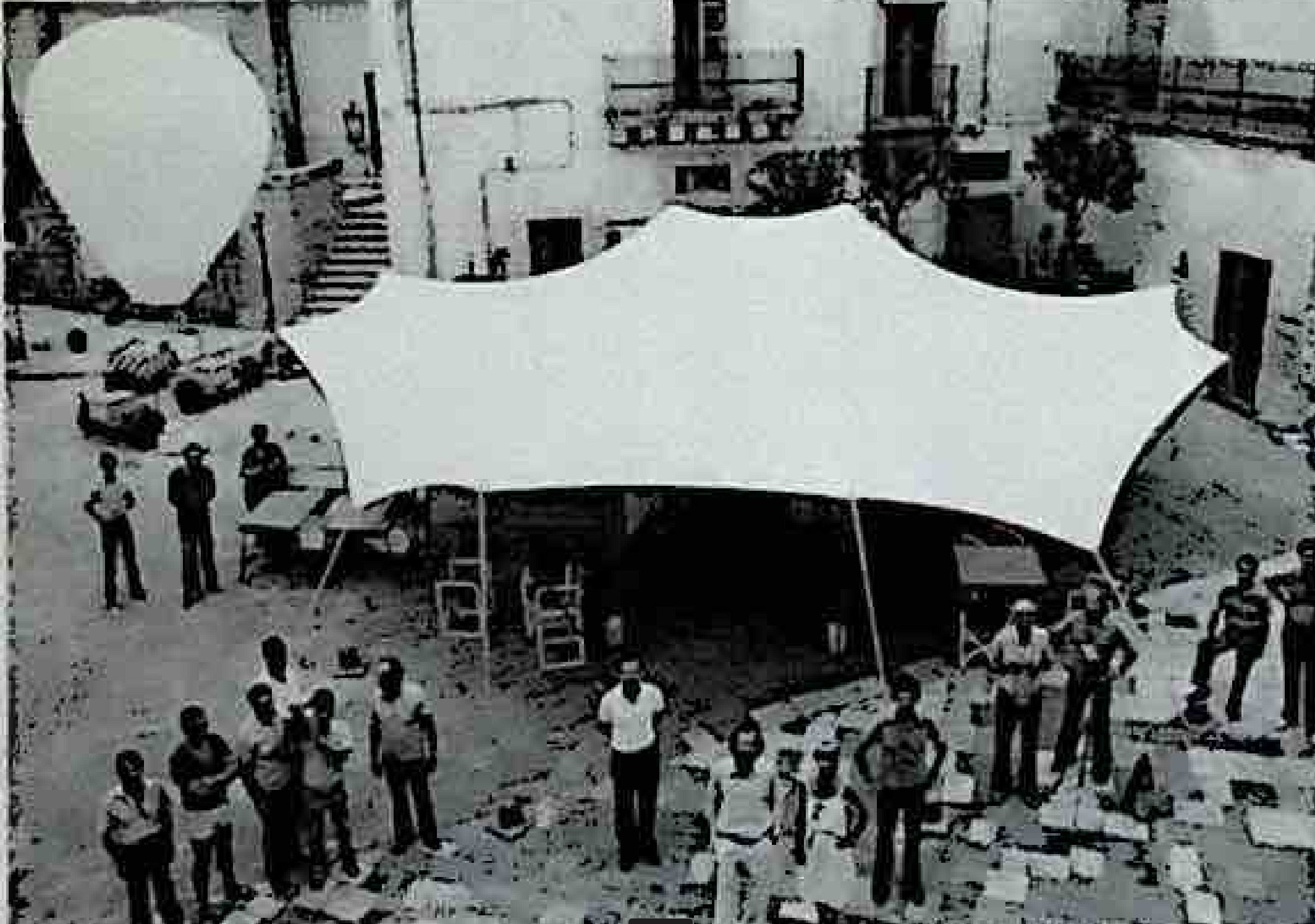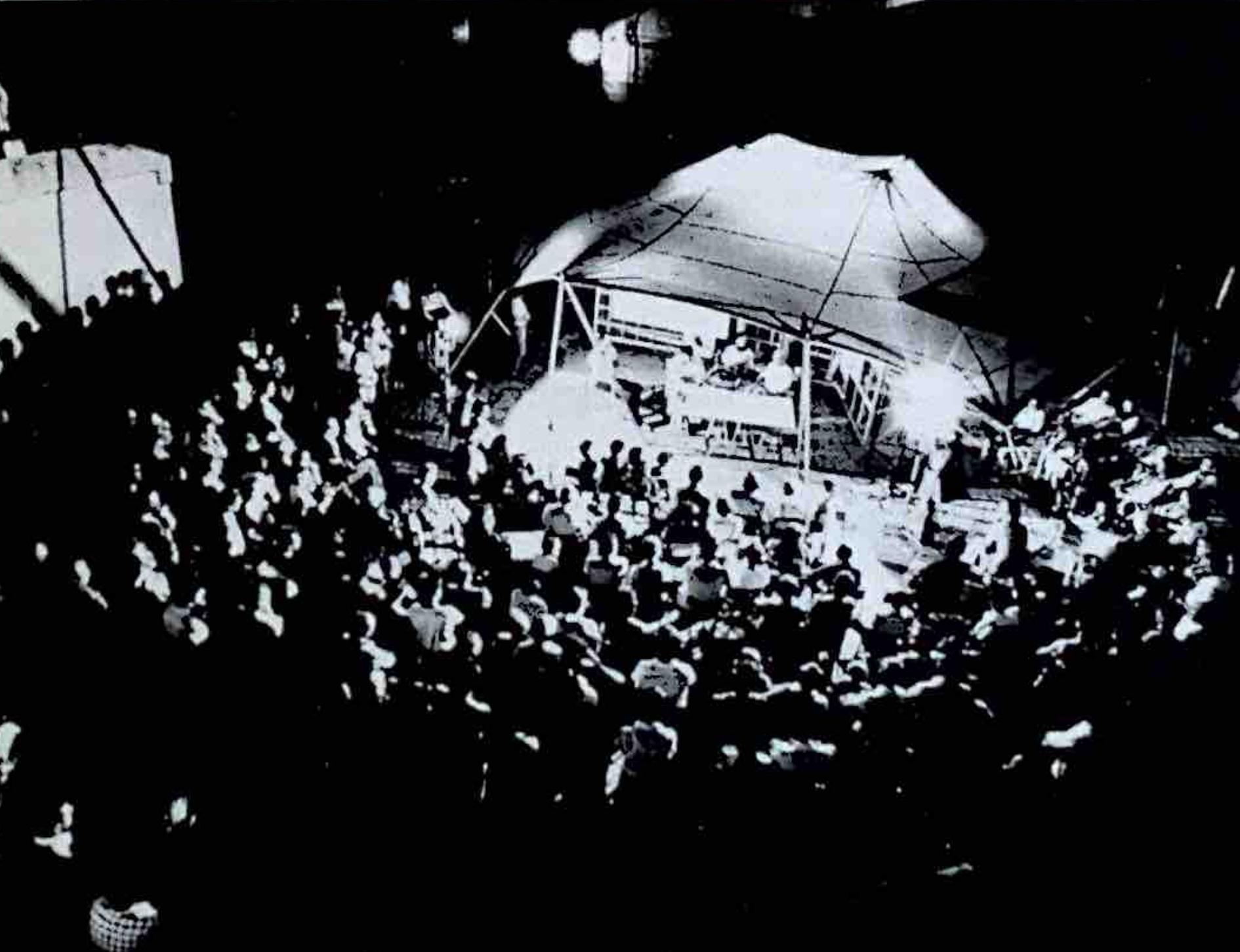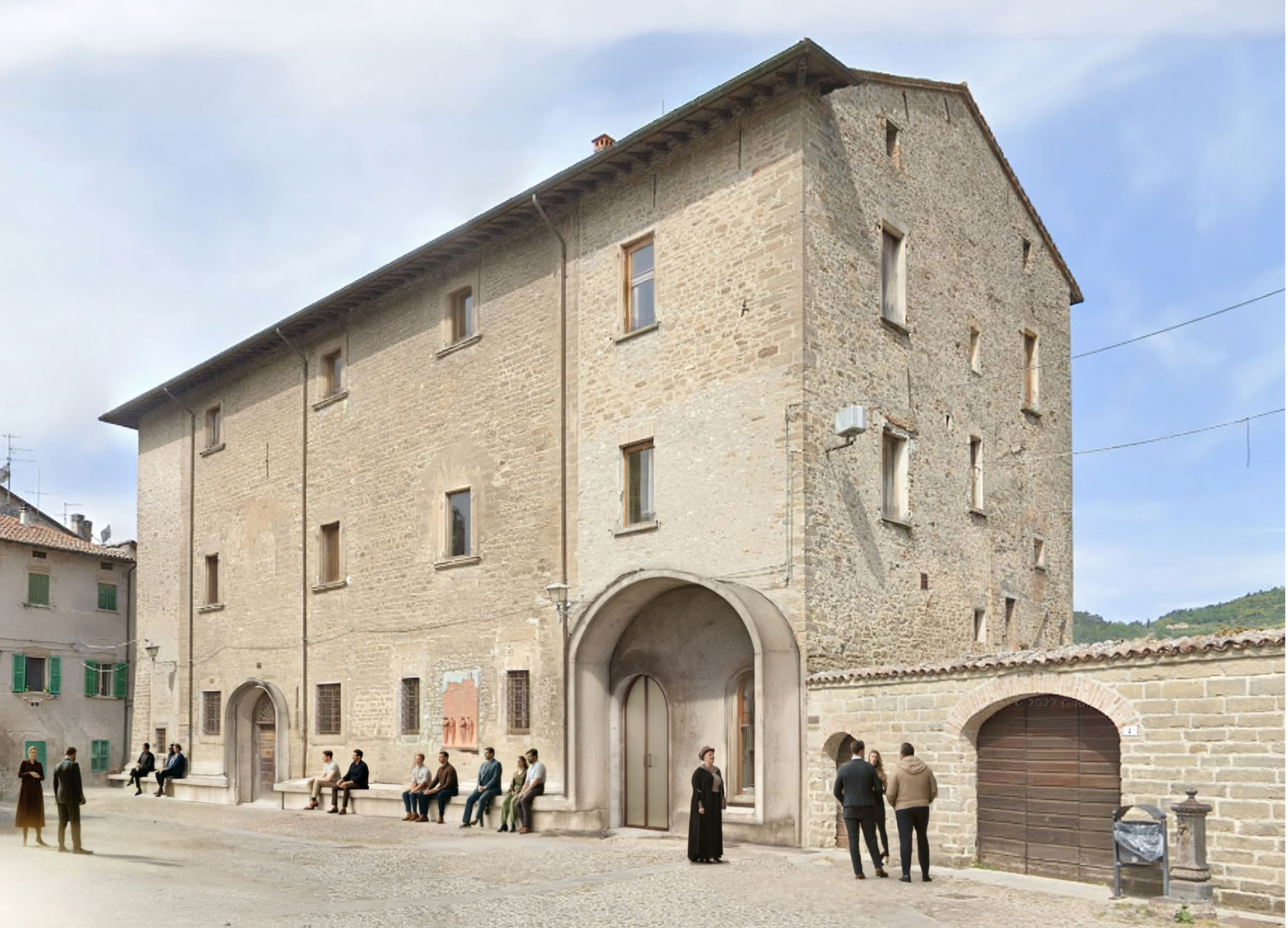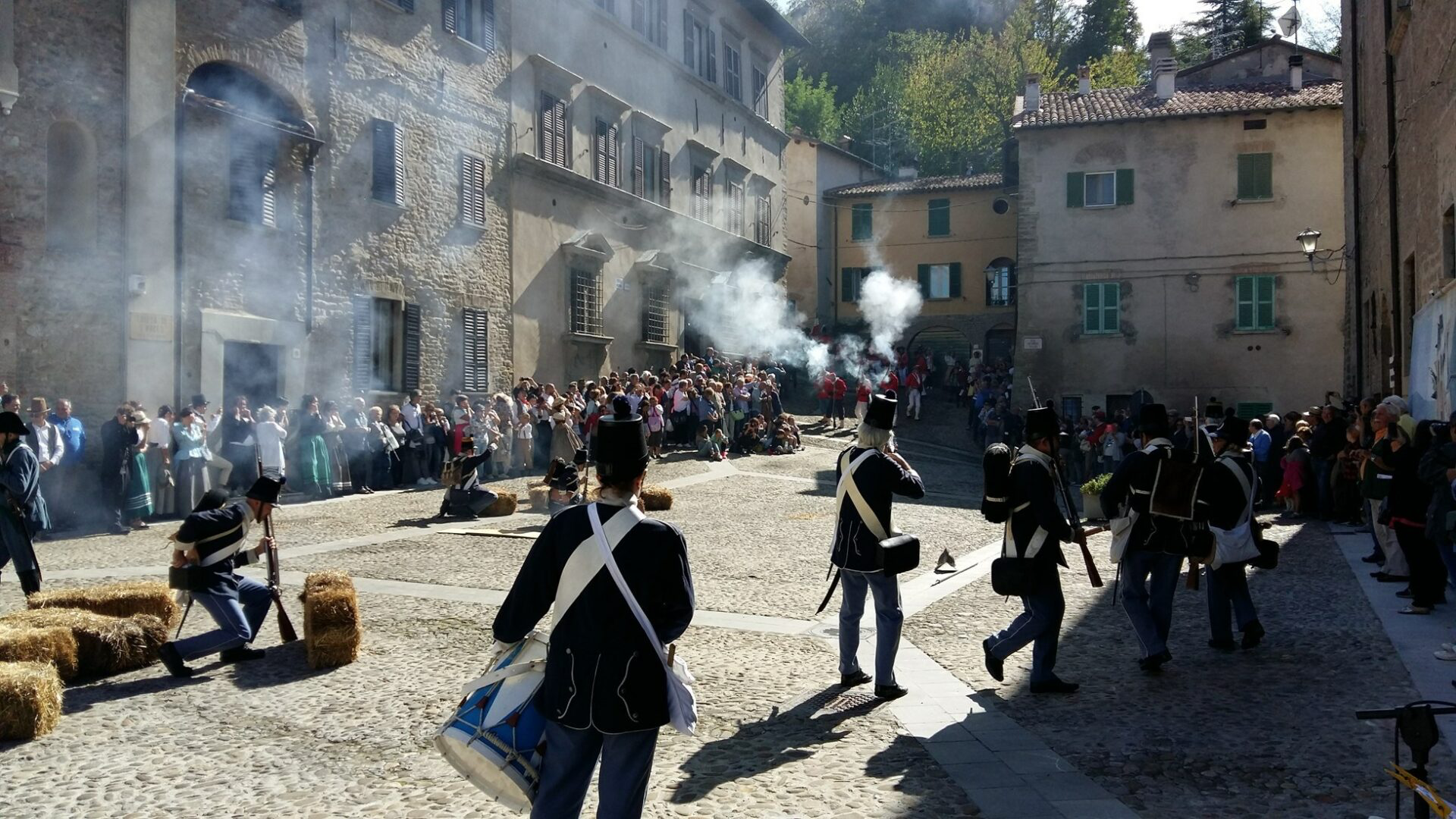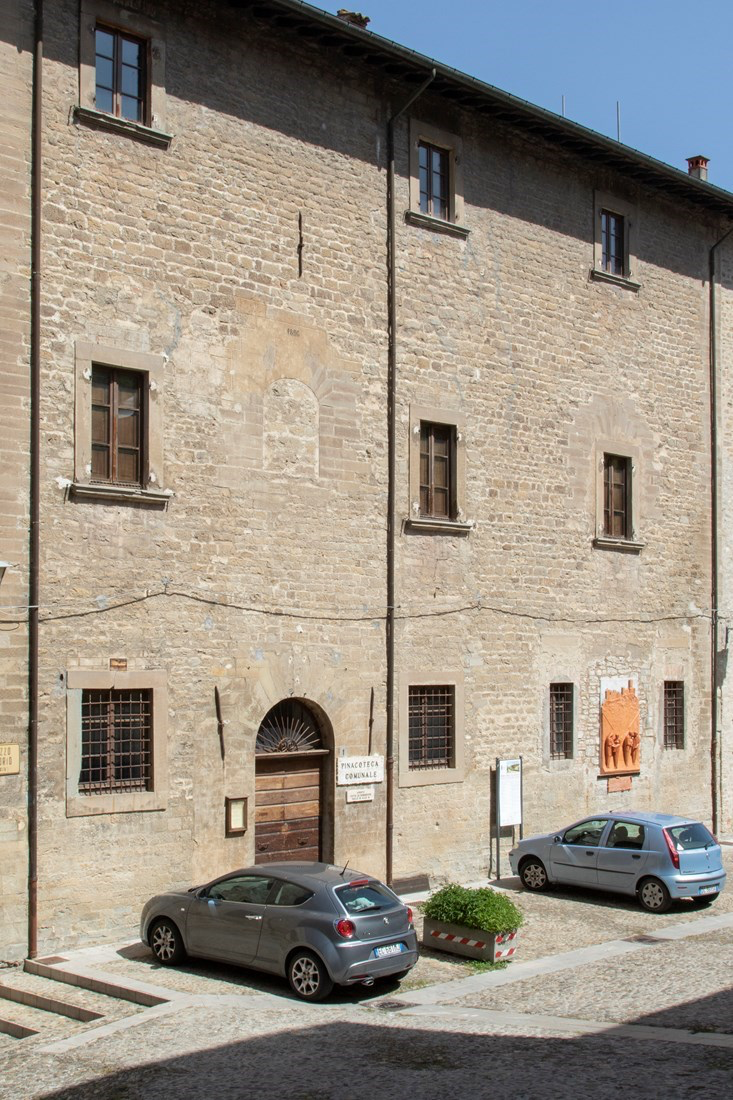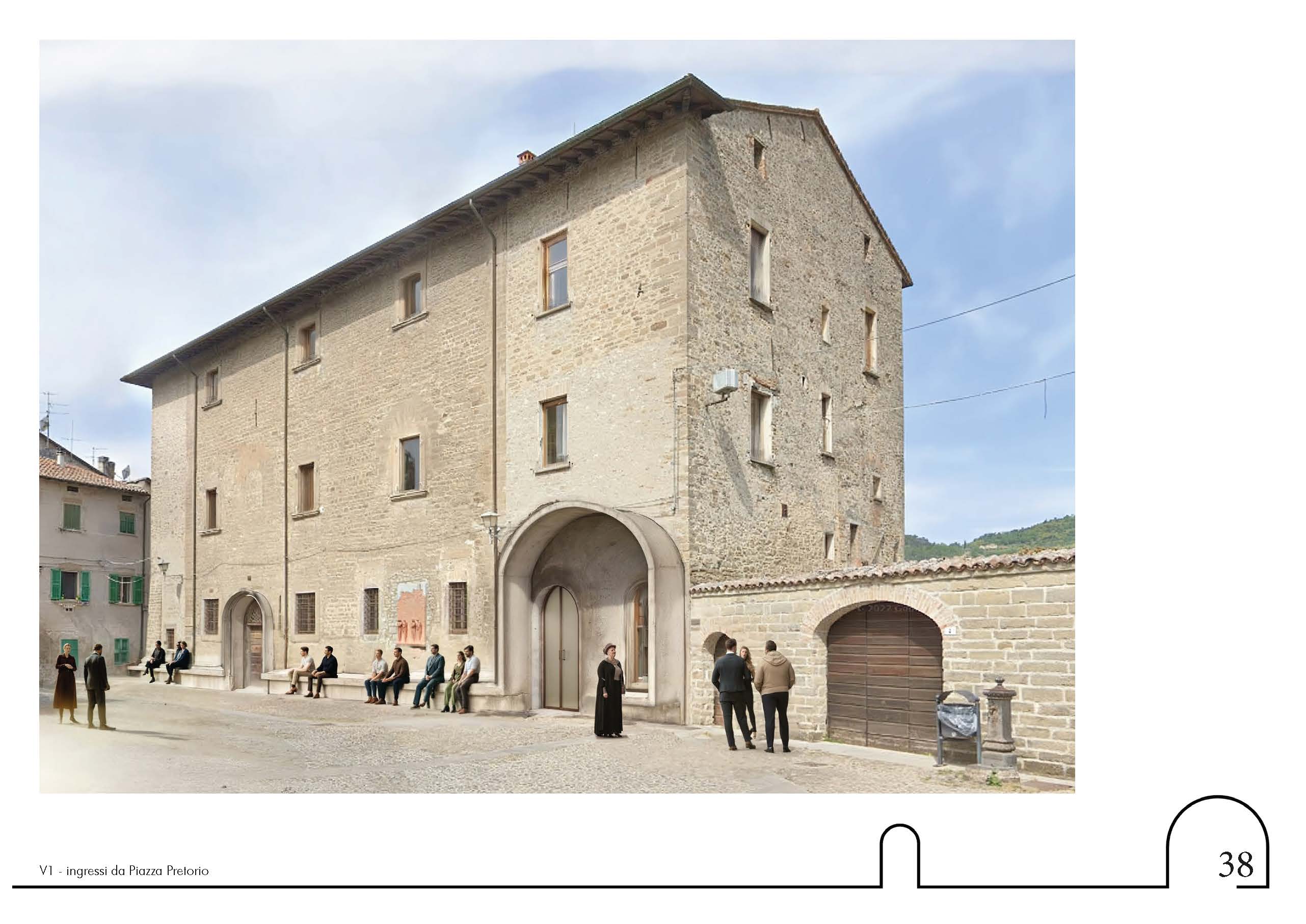MODIGLIANA FOR FUTURE
MODIGLIANA FOR FUTURE: sustainability, accessibility and beauty
Modigliana (4,295 inhabitants) is recovering from the May 2023 floods, facing 900 active landslides, and regenerating Pretorio Palace and Pretorio Square to revive its touristic vocation. Small mobile and transformable pavilions of wood and fabric will help revitalize the square, improve transparent communication on recovery and reconstruction phases, and encourage a new way of gathering in shaded public spaces, promoting beauty, collective care, and shared urban life.
Italy
Piazza Pretorio
47015, Modigliana (FC)
Italy
47015, Modigliana (FC)
Italy
Prototype level
Yes
Yes
Yes
No
No
040022: Modigliana (IT)
MODIGLIANA FOR FUTURE is a people-centered initiative aimed at rebuilding social networks post-disaster and ensuring transparent communication with local residents. It introduces a lightweight, movable info-point to support recovery efforts following the May 2023 floods, keeping supralocal reconstruction efforts, coordinated by Sogesid (Ministerial Commissioner for Reconstruction), tangible and relevant at the local level. The initiative involves citizens, local institutions, regional authorities, civil protection, and researchers.
Specific objectives are :
- Information campaign on the urban renovation of Piazza Pretorio and the Civic Pinacoteca;
- Information campaign on the reconstruction of Ca’ Stronchino Bridge, a key infrastructur
- bottom-up activities to support for the revitalization of Piazza Pretorio and its civic museum.
- civic engagement in the critical infrastructure reconstruction.
Key Development & Implementation Steps
1. Community Engagement & Info-Point
A physical info-point in Piazza Pretorio will serve as a direct communication hub between citizens, municipal representatives, and experts, counteracting the fragmentation of discussions on social media.
2. Temporary & Mobile Structure
A light, permeable tensile structure will embody transparency and adaptability, acting as an open book with sections on:
• Critical infrastructure
• Risk perception
• The future of Modigliana
3. Public Meetings & Knowledge Exchange
Regular workshops and discussions, inspired by the Otranto Historic Center Reconstruction Workshop (Renzo Piano Building Workshop, 1979), will facilitate participatory planning.
4. Scalability & Replication
A mobile info-point model will be adaptable to other flood-affected areas like Tredozio and Faenza.
5. Sustainability & Cultural Heritage
Discussions will integrate flood prevention, climate resilience, and heritage preservation.
Specific objectives are :
- Information campaign on the urban renovation of Piazza Pretorio and the Civic Pinacoteca;
- Information campaign on the reconstruction of Ca’ Stronchino Bridge, a key infrastructur
- bottom-up activities to support for the revitalization of Piazza Pretorio and its civic museum.
- civic engagement in the critical infrastructure reconstruction.
Key Development & Implementation Steps
1. Community Engagement & Info-Point
A physical info-point in Piazza Pretorio will serve as a direct communication hub between citizens, municipal representatives, and experts, counteracting the fragmentation of discussions on social media.
2. Temporary & Mobile Structure
A light, permeable tensile structure will embody transparency and adaptability, acting as an open book with sections on:
• Critical infrastructure
• Risk perception
• The future of Modigliana
3. Public Meetings & Knowledge Exchange
Regular workshops and discussions, inspired by the Otranto Historic Center Reconstruction Workshop (Renzo Piano Building Workshop, 1979), will facilitate participatory planning.
4. Scalability & Replication
A mobile info-point model will be adaptable to other flood-affected areas like Tredozio and Faenza.
5. Sustainability & Cultural Heritage
Discussions will integrate flood prevention, climate resilience, and heritage preservation.
Transparent communication
Qualification of open-air public spaces
Collective caring of the city
Multi-actor initiative for recovery and reconstruction
Shared use of art, material culture and public spaces
For about a century, the construction of the new road axis connecting Faenza, Modigliana, and Tredozio, built northwest of the original town center, has gradually created a separation from the old historic center, as indicated by the red dotted line. Commercial activities have therefore concentrated along the newly established route, gradually abandoning the mountain area located beyond the Tramazzo River. An urban regeneration intervention is necessary to counteract the phenomenon of depopulation and to redefine the conceptual boundaries of the city center, providing a new unified vision of both the old and new centers.
The main goal of renewing Pretorio Palace and its square: the multi-level regeneration process form the Palace to the Square, form the Square to the whole town.
The initiative will contribute to enhancing the economic, social, and environmental sustainability of Modigliana’s economy, further developing its slow tourism vocation and its role as a center for the preservation of local culture and the art of Macchiaioli painter Silvestro Lega. Additionally, it will serve as a hub for sharing this cultural heritage with other traditions, welcoming young artists in residence and attracting visitors interested in exploring the surrounding hill landscapes and hiking trails, including those in the Montebello Forest.
The main goal of renewing Pretorio Palace and its square: the multi-level regeneration process form the Palace to the Square, form the Square to the whole town.
The initiative will contribute to enhancing the economic, social, and environmental sustainability of Modigliana’s economy, further developing its slow tourism vocation and its role as a center for the preservation of local culture and the art of Macchiaioli painter Silvestro Lega. Additionally, it will serve as a hub for sharing this cultural heritage with other traditions, welcoming young artists in residence and attracting visitors interested in exploring the surrounding hill landscapes and hiking trails, including those in the Montebello Forest.
The project involves the restoration of a municipally owned building with the aim of significantly influencing the social and urban dynamics of the city of Modigliana. The building holds strategic importance for reconnecting parts of the city that have become disconnected—the historic center and the new focal point of the lower city.
The intervention, already approved by the Municipality of Modigliana through a council resolution attached to this proposal, focuses on the functional recovery of Palazzo Pretorio by repurposing abandoned areas. The goal is to return the palace and its square—historically key elements of the old center but now in a state of partial neglect—to the city.
Currently, Palazzo Pretorio houses the Civic Pinacoteca, but many parts of the building are in a deteriorated state, and the existing exhibition space does not ensure full accessibility. The municipality’s intention is to completely regenerate the old Pinacoteca and create a new cultural and social hub centered around Silvestro Lega, a Macchiaioli painter of worldwide renown who was born in Modigliana. This new hub will be operational for most of the day, as in addition to the Pinacoteca, the ground floor spaces will include leisure areas such as a café and a wine bar promoting high-quality regional and national wine products with strong appeal.
At the same time, the municipality also plans to visually restore the adjacent square as a social gathering space by relocating the current parking areas. Piazza Pretorio, directly in front of the building, is considered an integral part of the project, ensuring its full functionality once the palace is renovated. Currently, this is the oldest and perhaps most beautiful square in Modigliana, but it has been overtaken by cars. The intervention aims to return the palace to the square and the square to the city. Inspired by Tuscan palaces such as Palazzo Rucellai and Palazzo Piccolomini in Florence, the project envisions more beauty for the city.
The intervention, already approved by the Municipality of Modigliana through a council resolution attached to this proposal, focuses on the functional recovery of Palazzo Pretorio by repurposing abandoned areas. The goal is to return the palace and its square—historically key elements of the old center but now in a state of partial neglect—to the city.
Currently, Palazzo Pretorio houses the Civic Pinacoteca, but many parts of the building are in a deteriorated state, and the existing exhibition space does not ensure full accessibility. The municipality’s intention is to completely regenerate the old Pinacoteca and create a new cultural and social hub centered around Silvestro Lega, a Macchiaioli painter of worldwide renown who was born in Modigliana. This new hub will be operational for most of the day, as in addition to the Pinacoteca, the ground floor spaces will include leisure areas such as a café and a wine bar promoting high-quality regional and national wine products with strong appeal.
At the same time, the municipality also plans to visually restore the adjacent square as a social gathering space by relocating the current parking areas. Piazza Pretorio, directly in front of the building, is considered an integral part of the project, ensuring its full functionality once the palace is renovated. Currently, this is the oldest and perhaps most beautiful square in Modigliana, but it has been overtaken by cars. The intervention aims to return the palace to the square and the square to the city. Inspired by Tuscan palaces such as Palazzo Rucellai and Palazzo Piccolomini in Florence, the project envisions more beauty for the city.
The project envisions a seating area interspersed with two elegant arches, in harmony with the original architectural style of the palace. Through the redeveloped architecture of the palace, the project aspires to a profound urban regeneration, capable not only of revitalizing an abandoned part of the city but also of reconnecting the entire urban fabric.
This urban regeneration process aims to be as transparent as possible. It is an initiative launched by the municipality and has already been presented to citizens during a public assembly, where residents had the opportunity to engage and provide critical support to the proposal, becoming optimal both at the level of the affordability and at the level of accessibility (see the project in the annexes).
This urban regeneration process aims to be as transparent as possible. It is an initiative launched by the municipality and has already been presented to citizens during a public assembly, where residents had the opportunity to engage and provide critical support to the proposal, becoming optimal both at the level of the affordability and at the level of accessibility (see the project in the annexes).
This urban regeneration process aims to be as transparent as possible. It is an initiative launched by the municipality and has already been presented to citizens during a public assembly, where residents had the opportunity to engage and provide critical support to the proposal.
At the same time, Modigliana is undergoing a multitude of interventions on its main road infrastructures surrounding the town, as well as maintenance work on the riverbeds of the three streams that flow through it. Modigliana was, in fact, one of the municipalities most affected by the May 2023 flood. Due to these extraordinary events and the resulting emergency, the Italian government declared a state of emergency and appointed a special commissioner to oversee the reconstruction efforts.
Simultaneously, the Politecnico di Milano has signed a framework agreement with the Municipality of Modigliana, representing all the municipalities affected by the Emilia-Romagna May 2023 flood. Through this four-year agreement, the Municipality of Modigliana has had the opportunity to involve citizens in participatory listening processes and provide scientific and technical support, ensuring that reconstruction efforts—managed from the top down by the ministerial commissioner—can also be addressed from the bottom up in a shared and community-driven manner.
The NEB Prize proposal aims to intersect these two levels of ongoing operations in Modigliana. On one hand, it seeks to communicate the urban regeneration projects that the municipality has already planned, particularly focusing on Piazza Pretorio and Palazzo Pretorio. On the other, it aims to keep citizens continuously informed about the reconstruction efforts managed externally by the commissioner’s office.
At the same time, Modigliana is undergoing a multitude of interventions on its main road infrastructures surrounding the town, as well as maintenance work on the riverbeds of the three streams that flow through it. Modigliana was, in fact, one of the municipalities most affected by the May 2023 flood. Due to these extraordinary events and the resulting emergency, the Italian government declared a state of emergency and appointed a special commissioner to oversee the reconstruction efforts.
Simultaneously, the Politecnico di Milano has signed a framework agreement with the Municipality of Modigliana, representing all the municipalities affected by the Emilia-Romagna May 2023 flood. Through this four-year agreement, the Municipality of Modigliana has had the opportunity to involve citizens in participatory listening processes and provide scientific and technical support, ensuring that reconstruction efforts—managed from the top down by the ministerial commissioner—can also be addressed from the bottom up in a shared and community-driven manner.
The NEB Prize proposal aims to intersect these two levels of ongoing operations in Modigliana. On one hand, it seeks to communicate the urban regeneration projects that the municipality has already planned, particularly focusing on Piazza Pretorio and Palazzo Pretorio. On the other, it aims to keep citizens continuously informed about the reconstruction efforts managed externally by the commissioner’s office.
The proposal for the NEB Prize specifically envisions Piazza Pretorio as a dynamic space, where small temporary wooden and fabric structures can be installed in rotation. These structures would serve as information hubs, collecting and disseminating updates from citizens, the local administration, or the designated commissioner-led reconstruction teams.
In an era where most communications are delivered via social media, these temporary structures aim to restore a local and physical dimension to public communication, fostering direct interaction among people. Easily movable and reconfigurable, they will provide communication support whenever a new issue arises.
There is also a growing public perception that extreme weather events will become increasingly frequent in Modigliana, yet there is currently no detailed and well-defined plan on how to respond to these climate change-related incidents. Together with the Politecnico di Milano, the Municipality of Modigliana is working on the sharing of information and raising awareness about the real risks the community is facing in this period of climatic transformation.
In an era where most communications are delivered via social media, these temporary structures aim to restore a local and physical dimension to public communication, fostering direct interaction among people. Easily movable and reconfigurable, they will provide communication support whenever a new issue arises.
There is also a growing public perception that extreme weather events will become increasingly frequent in Modigliana, yet there is currently no detailed and well-defined plan on how to respond to these climate change-related incidents. Together with the Politecnico di Milano, the Municipality of Modigliana is working on the sharing of information and raising awareness about the real risks the community is facing in this period of climatic transformation.
The initiative aims to leverage a broad range of scientific disciplines through the expertise of the Politecnico di Milano, which is involved in a four-year Framework Agreement with the Municipality of Modigliana. These disciplines include architecture, urban planning, engineering, construction, geotechnics, social sciences, and environmental hygiene. Modigliana Municipality and Politecnico di Milano already experimented this formula in the REFLOAT-ER project (see annexes).
The most innovative aspect of this proposal is its aim to bring citizens together in a shared social experience within the newly regenerated urban space, at a time when social media has become the dominant platform for communication about progress and new developments.
These small, ephemeral, and mobile structures are designed to become a physical space where people can reconnect and revive social interactions, which are increasingly forgotten or neglected.
The removal of architectural barriers in the square and museum will ensure that these shaded, movable structures are fully accessible, especially for elderly citizens, who represent the majority of Modigliana’s population.
The ability to reuse these small mobile structures to host visitors and tourists during outdoor events will help reactivate the entire urban space. It will also foster interaction between citizens and external visitors, bringing new energy to one of the least utilized areas of the town.
These small, ephemeral, and mobile structures are designed to become a physical space where people can reconnect and revive social interactions, which are increasingly forgotten or neglected.
The removal of architectural barriers in the square and museum will ensure that these shaded, movable structures are fully accessible, especially for elderly citizens, who represent the majority of Modigliana’s population.
The ability to reuse these small mobile structures to host visitors and tourists during outdoor events will help reactivate the entire urban space. It will also foster interaction between citizens and external visitors, bringing new energy to one of the least utilized areas of the town.
The initiative aims to leverage a broad range of scientific disciplines through the expertise of the Politecnico di Milano, which is involved in a four-year Framework Agreement with the Municipality of Modigliana. These disciplines include architecture, urban planning, engineering, construction, geotechnics, social sciences, and environmental hygiene. Modigliana Municipality and Politecnico di Milano already experimented this formula in the REFLOAT-ER project (see annexes, website: www.refloater.polimi.it).
Through this multidisciplinary approach, the Municipality of Modigliana, supported by the Politecnico di Milano, will provide accurate and relevant information to citizens while also gathering their input, following the model already implemented during public meetings held in March 2024, after the 2023 flood.
The methodology follows a participatory approach, organizing focus groups and parallel working tables where specialists meet citizens, who can join discussions based on their preferences, needs, and urgent concerns.
This initiative has a multi-level objective:
• To communicate ongoing urban regeneration projects effectively.
• To listen to citizens’ concerns regarding new urban management strategies, particularly those aimed at reducing car dependency, implementing sustainable electric public transport, and overcoming physical barriers between the historic center, the hospital area, and the lower town, which is more vulnerable to flooding.
Focusing on Piazza Pretorio also carries a symbolic significance—as the safest area in case of future floods, it can serve as a resilient public space for the community.
Through this initiative, the goal is to enhance the accessibility and usability of Modigliana’s highest, most beautiful, and safest square, while promoting new outdoor lifestyles. This will help raise awareness among citizens about the urgency of reducing or abandoning fossil-fuel vehicles in favor of more sustainable mobility solutions.
Through this multidisciplinary approach, the Municipality of Modigliana, supported by the Politecnico di Milano, will provide accurate and relevant information to citizens while also gathering their input, following the model already implemented during public meetings held in March 2024, after the 2023 flood.
The methodology follows a participatory approach, organizing focus groups and parallel working tables where specialists meet citizens, who can join discussions based on their preferences, needs, and urgent concerns.
This initiative has a multi-level objective:
• To communicate ongoing urban regeneration projects effectively.
• To listen to citizens’ concerns regarding new urban management strategies, particularly those aimed at reducing car dependency, implementing sustainable electric public transport, and overcoming physical barriers between the historic center, the hospital area, and the lower town, which is more vulnerable to flooding.
Focusing on Piazza Pretorio also carries a symbolic significance—as the safest area in case of future floods, it can serve as a resilient public space for the community.
Through this initiative, the goal is to enhance the accessibility and usability of Modigliana’s highest, most beautiful, and safest square, while promoting new outdoor lifestyles. This will help raise awareness among citizens about the urgency of reducing or abandoning fossil-fuel vehicles in favor of more sustainable mobility solutions.
The Modigliana for Future initiative is committed to transparent, community-driven reconstruction, ensuring sustained dialogue and engagement. By creating a replicable framework, the initiative contributes to resilient recovery in Modigliana and beyond.
Development of a mobile info-point model adaptable to other flood-affected areas like Tredozio, Rocca San Casciano and Faenza. The concept of replicability applies not only to the temporary structures but also to the entire citizen engagement model and the interactive framework between public officials, technical experts, and residents.
Extending this listening and information-sharing model to other flood-affected areas allows for comparative analysis and knowledge exchange. Regional and provincial representatives will also be invited, creating opportunities for fruitful discussions and comparisons of different operational methodologies.
Development of a mobile info-point model adaptable to other flood-affected areas like Tredozio, Rocca San Casciano and Faenza. The concept of replicability applies not only to the temporary structures but also to the entire citizen engagement model and the interactive framework between public officials, technical experts, and residents.
Extending this listening and information-sharing model to other flood-affected areas allows for comparative analysis and knowledge exchange. Regional and provincial representatives will also be invited, creating opportunities for fruitful discussions and comparisons of different operational methodologies.
The first challenge of this project is undoubtedly climate change. Modigliana, a small town at risk of potential relocation, is implementing a series of strategies to enhance the resilience of its territory.
This initiative serves as the first step in educating citizens about the risks they face, increasing their resilience, and fostering a collective approach to finding solutions. By leveraging grassroots knowledge and expertise, the community can work together to prevent depopulation and promote a sustainable, long-term care for the territory.
We believe that a transparent, continuous, and physical communication process from the bottom-up will improve the effectiveness of information flow and operational coordination between public administrators and technical experts. At the same time, it will highlight and integrate the skills of individual citizens and local associations, making them active participants in the town’s sustainable future.
This initiative serves as the first step in educating citizens about the risks they face, increasing their resilience, and fostering a collective approach to finding solutions. By leveraging grassroots knowledge and expertise, the community can work together to prevent depopulation and promote a sustainable, long-term care for the territory.
We believe that a transparent, continuous, and physical communication process from the bottom-up will improve the effectiveness of information flow and operational coordination between public administrators and technical experts. At the same time, it will highlight and integrate the skills of individual citizens and local associations, making them active participants in the town’s sustainable future.
The initiative is promoted by the Department of Culture, Sports, Youth Activities, and Tourism, with the goal of being replicable and adaptable to various aspects of municipal life, including sports, recreational activities, and tourism events. It is designed for implementation not only within Modigliana but also within the Union of Municipalities of Romagna Forlivese and the Municipality of Faenza (Ravenna province), which serves as the main connection to the Via Emilia.
The initiative will be replicable in multiple contexts, starting with the Municipality of Tredozio, followed by Rocca San Casciano, Faenza, and potentially other municipalities. Over the two-year period, further opportunities for expansion and collaboration will be explored to maximize the initiative’s impact.
The initiative will be replicable in multiple contexts, starting with the Municipality of Tredozio, followed by Rocca San Casciano, Faenza, and potentially other municipalities. Over the two-year period, further opportunities for expansion and collaboration will be explored to maximize the initiative’s impact.

